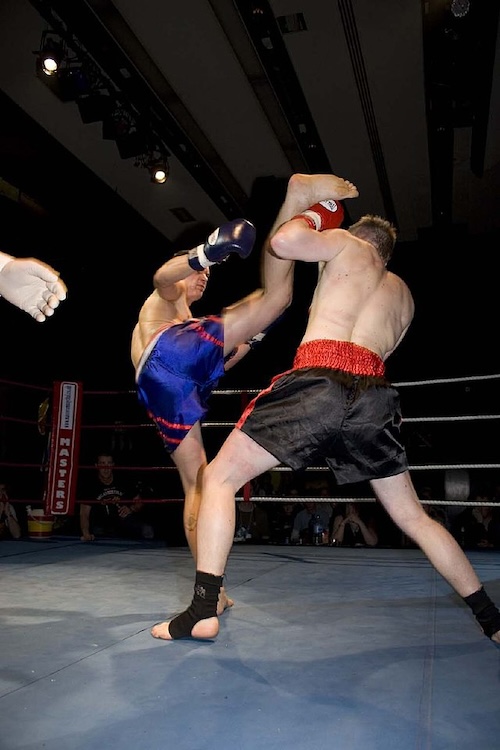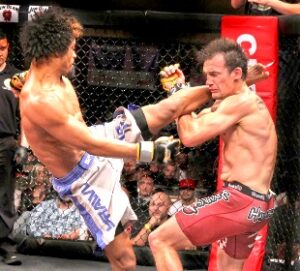
Are you wondering how to kick higher in Muay Thai and MMA?
In this article, we’ll look at how to kick higher in Muay Thai and MMA by following a simple 4-step guide.
Contents
How To Kick Higher in Muay Thai and MMA
To kick higher in muay Thai and MMA, three areas must be worked on:
- Improve hip extension/flexibility (80%)
- Strengthen muscles (10%)
- Practice high kick routines often (10%)
1. Improve Hip Extension / Flexibility
80% of the ability to kick higher in Muay Thai and MMA is reliant on improving hip extension and flexibility – so it’s where your focus should be.
Improved hip extension allows fighters to kick higher as the hips and adductors (inner thigh muscles) aren’t tight and restricting extension.
Before any form of stretching, make sure to warm up for 5 minutes beforehand with light movement or bodyweight exercises to avoid injury.
Hip extension and flexibility routines can be split into specific and nonspecific for kicking higher.
Nonspecific is general stretching routines for the hamstrings, quads, calves, glutes, and hips. Specific is stretching with kicking-specific movements which also practice technique simultaneously.
Hip extension and flexibility routines can be done every day, but beginners should start with 2 or 3 times per week for 1 month before adding an extra day each week.
It’s best to improve mostly through specific kick stretching, so 2/3 specific sessions and 1 nonspecific is best.
Specific High Hick Stretching Routine
Specific high-kicking stretching can be done with various routines, but they must take you through the various stages of a kick.
Here’s an example routine:
Complete each exercise for each leg, hold a chair for balance if needed, and keep the standing leg facing between 45 to 90 degrees to the opposite side of the kicking leg to recreate the end of a pivot and fully open up the hips.
Extend your range of motion progressively to avoid injury.
1. Side of roundhouse kick position
Keeping the kicking leg straight, lift it out to the side as high as comfortably possible and hold for 30-45 seconds.
This increases balance, range of motion, and muscular endurance, and strengthens the hip and glute muscles. Over time, you’ll be able to lift the leg and kick higher as a result.
2. Swing the leg low to high
Swing the kicking leg as high as possible and back down past the standing leg as far as possible. Complete 10 reps, swing in a controlled manner to avoid injury, and keep the heel as high as the toes.
3. Side leg hold at 3 different heights
Similar to exercise 1, keeping the kicking leg straight, lift it out to the side and hold the leg at its highest position, then lower it to a height that’s still challenging, and then to a lower position.
Hold each position for 5 seconds and repeat 3 times before letting the kicking leg touch the ground.
4. Lift the knee
Lift the leg to the side so the legs are 90 degrees, bring the foot back to the glutes, and with the free hand pull the knee upward while leaning back slightly in the opposite direction to the kick. Hold for 30 seconds.
5. Up and down the knee
Lift the leg to the side so the legs are 90 degrees, bring the foot back to the glutes, and with the knee go up and down slightly off the centerline in a controlled motion for around 50 reps or as many as you can do.
Cover a 6-inch range of motion with the knee and don’t use the free hand to lift the knee. As it gets easier, the starting and lowest points of the knee should be greater.
6. Chamber and extensions
Lift the leg to the side so the legs are 90 degrees, bring the foot back to the glutes (chamber), and kick out the lower leg (extension).
Keep the height the same and repeat for 50 seconds. The reps should be controlled so that there are 1 to 2 seconds between each chamber and extension.
Finish the routine by rotating the hips out in a circle, clockwise and anticlockwise. The total time for this routine is around 20 minutes.
Nonspecific High Kick Stretching Routine
Here’s an example of a nonspecific high kick stretching routine, of which there are many that work.
- Deep Lunge
- Deeper Lateral Lunge
- Pike stretch (standing/sitting)
- Lean back
- Foot grab back stretch
- Wall splits
- Butterfly
- Open splits leaning rotation
- Double leg foot grab
- Pigeon pose
Take a 10 to 15-second break between each exercise, hold each stretch for 30 seconds, and make sure to stretch both sides the same.
Here’s a great nonspecific high-kick stretching routine that you can follow if you prefer visual aids:
2. Strengthen Muscles
Strengthening muscles is also required to kick higher. When muscles are strengthened, it enables the stretching of the tendons, ligaments, and muscles used to go further than they previously could.
Also, strength and flexibility combined lead to great balance, which is essential for kicking higher. Lastly, strengthening muscles corrects muscle imbalances, improves posture, and prevents injuries that can hinder the ability to kick higher.
As strengthening muscles represents only 10 to 20% of the results, it shouldn’t be the main focus and workouts should be kept simple and effective.
Strengthen the Core
The most important area to strengthen to kick higher is the core as it improves balance and body control and it also simultaneously strengthens the abs, hips, lower back, and pelvis.
Similar to hip extension and flexibility workouts, core workouts should be done 2-3 times per week and can be done on alternating days. Core workouts should be 10-15 minutes of 3 or 4 exercises and 3 or 4 sets for each.
The best core strengthening exercises are:
- Planks
- Crunch: reverse crunch, oblique crunch, bicycle crunch (any variation)
- Ab roller
- Deadlifts
- Squats
Strengthen Quads and Glutes
The best quads and glutes strengthening exercises are:
- Squats, bodyweight squats, pistol squats (plus other variations)
- Deadlifts (any variation)
- Lunge, reverse lunge
- Barbell hip thrust
- Donkey kicks
Strengthen Hips
The best hip-strengthening exercises are:
- Hip thrusts
- Deadlift
- Straight leg raise
- Power clean
- Bridges
Strengthen Hamstrings
The best hamstring strengthening exercises are:
- Conventional deadlift, Romanian deadlift, single-leg deadlift
- Rack pull
- Hamstring curls
- Nordic hamstring curls
- Kettlebell swings
3. Practice High Kick Routines Often
To kick higher in Muay Thai and MMA, fighters practice proper kicking techniques repeatedly. The best way to do this is to practice high kick routines and hip mobility drills.
Practicing high kicks with proper technique is the hardest to do while keeping balance, and it allows a fighter to continually test if their kicks are getting higher.
Keeping proper technique means injuries are prevented and kicks are more effective when fighting.
A high kick routine is broken down into the kick’s components, step by step. The complete kicking movement is then repeated at the end.
Here’s an example routine:
- Chambering (Starting Points and Extension From Starting Point)
- Machine Gun Kick
- Side Kick
- Side Kick Pulse
- Outside Egg Beater
- Inside Egg Beater
Here’s a video of UFC fighter Brad Riddell and taekwondo Hall of Famer Carl Van Roon sharing a high kick routine.
4. Let Injuries Heal
It’s possible for a fighter to be stretching, strengthening muscles, and practicing high kick routines, but have an injury preventing them from kicking higher.
So, to kick higher in Muay Thai and MMA, let injuries fully heal. With bad hips, fighters should consult an orthopedic surgeon for diagnosis before they can kick higher. Some injuries only need rest and others may need surgery.
Personalization
It’s important to remember that everyone’s body is different, and individuals may progress at varying rates.
Listen to your body and adjust the intensity and frequency of your exercises accordingly.
If you experience any pain or discomfort, take a step back and consult with a healthcare professional if necessary.
The key is consistency and patience; over time, you’ll see improvements in your flexibility and kicking height.
The Bottom Line
In summary, kicking higher in Muay Thai and MMA requires a focus on improving hip extension and flexibility, strengthening the relevant muscles, and practicing high kick routines regularly.
By following this 4-step guide and listening to your body, you can gradually increase your kicking height and enhance your overall performance in the sport. Stay committed to your training, and you’ll reap the rewards in the ring.




